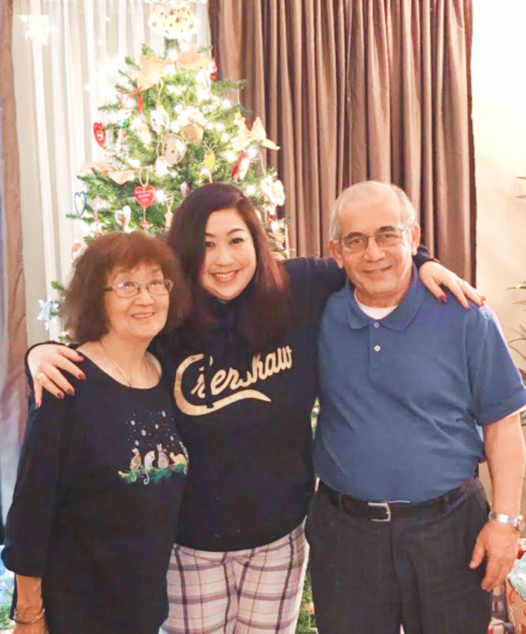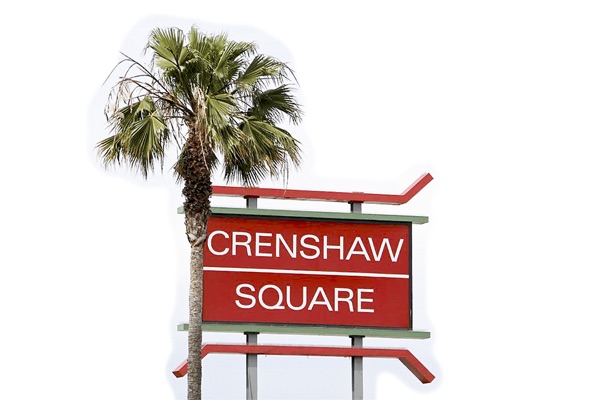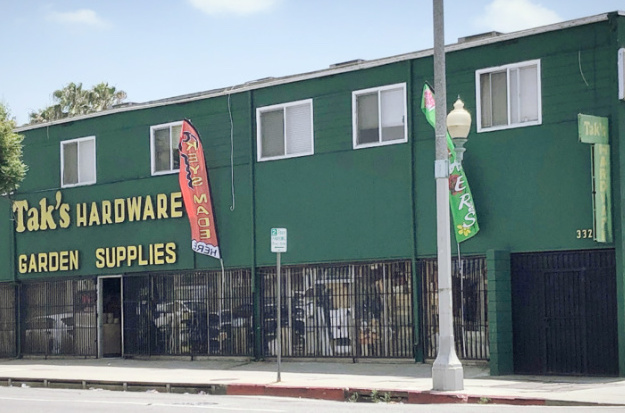Tak’s Hardware on Jefferson Boulevard in South Los Angeles is a vestige of a once-vibrant Japanese American community that resided in the city’s largely African American district. (Photo: Tak Kikuchi)
The writer reflects on the area’s influence on who she is today — and the lasting footprints JA’s have made as a vital part of that history.
By Athena Mari Asklipiadis, Contributor
In the last few months, it has been nearly impossible to miss the mentions of rapper Nipsey Hussle and filmmaker John Singleton in the news. Both celebrities, whose deaths dominated headlines in the spring, each hailed from South Los Angeles.
The pride they had for their African-American roots and their neighborhood is something that they not only referenced in their work, but also made a focal point — voicing ’hood stories from a raw first-hand point of view.
In addition to their enormous creative talents, they may be arguably best remembered for their advocacy work for the people in their community. “Crenshaw” is now becoming synonymous with the late rapper, his loss spotlighting this culturally rich, but sometimes troubled, part of Los Angeles, located a few miles south of Downtown L.A.
While seeing the recent images of South L.A. woven into their biographies, I couldn’t help but think of what once was and how different things were for my family living here in earlier days.

Author Athena Asklipiadis, wearing a Nipsey Hussle hooded sweatshirt and flanked by her parents, during Christmas of 2018. (Photo courtesy of the Asklipiadis family)
The area is now widely referred to as a “black community,” but it has a lingering Japanese American footprint that still remains visible. It made me wonder if many people today know of our existence and the Japanese American history here in this place.
Even during the 1990s and 2000s, dominant Asian American depictions in the news or films located in the area mostly highlighted Korean American characters rather than JA’s.
In the 2000 comedy film “Next Friday,” the only Asian role was that of a comical neighbor, Mrs. Ho-Kim (played by Japanese-Finnish American actress Amy Hill). In Singleton’s Oscar-nominated 1991 film “Boyz n the Hood,” a billboard read “Seoul to Seoul Realty” and mentioned only Koreans in the scene about gentrification and the area’s changing diversity.
The Japanese American voice and image has been largely invisible within the South L.A. cinematic narrative, but it has always been such a huge part in building the area into what is is today.
Reflections raced through my mind of my own family story, as well as questions about the shifting demographics of the area.
Where are our stories?
As I walked from home to attend Nipsey Hussle’s funeral procession on April 11 (Hussle was gunned down in the parking lot of his clothing store in South L.A. on March 31), I rapidly noticed that I was definitely the only Asian-looking face in a sea of everything but.
I found a good viewing spot just outside of Angelus Funeral Home on South Crenshaw Boulevard, in direct view of the Crenshaw Square sign, and for the first time in a while, I thought about how truly Japanese its style is.
The sign, which has changed in font and color over the last few decades, still maintains its original torii-esque design. Torii or 鳥居, literally means “bird abode,” and according to Wikipedia, is a “traditional Japanese gate most commonly found at the entrance of or within a Shinto shrine, where it symbolically marks the transition from the mundane to the sacred.”
Its style origin dates back to Japan’s Heian Period to year 922. Coincidentally, Hussle’s first paid gig as a rapper was actually in Japan, and he eventually released a music video filmed entirely there, depicting Tokyo’s famous Yasukuni torii and shrine.
As the crowd at Hussle’s funeral procession grew, I got the usual inquiring stares and the subtle questions that I have grown used to over the years. When people ask where I am from, insinuating I’m not likely local, I eagerly reply, “Here, I’m from down the street, I grew up in this area.” This answer is usually met with surprised reactions.
Even while donning a “Crenshaw” hoodie from Hussle’s clothing line, I still knew I would appear, to the mostly young crowd, as a newbie, a bandwagon fan or the most recent assumptions in the area — a gentrifier, a house flipper or a transplant who took the Metro line from the Westside.
Most never guess that for my whole life, my family has lived and worked in South L.A. My grandparents first moved to the area in the 1920s (minus the time surrounding their internment), helping to establish Los Angeles Holiness Church on South Gramercy Avenue and 36th Place.
Wearing Hussle’s apparel makes me feel a renewed sense of the pride I have always wanted to display for my hometown, but never could gather the courage for. He made the name “Crenshaw” popular and cool by branding it through his line, the Marathon Clothing (TMC).
I also wear the brand because I am a fan of his music and his commitment to our community. Role models who remember where they come from and give back are always heroes of mine.
Before his passing, my hoodies mostly served as conversation pieces about both the boulevard and neighborhood area more than the rapper himself. When asked about it, I would explain who Nipsey Hussle was, since he wasn’t as widely known then, and that I was reppin’ my home.
It often became an unplanned opportunity to explain how the community was in the past and how my family and I came to be there. It was a way for me to feel like I could belong, even though I did not always feel or look the typical part.
As a longtime South L.A. resident, my pride for my neighborhood has been a rocky journey to say the least.

The Crenshaw Square Sign, seen here in 2019, retains the same “torii” gate shape as the vintage sign. (Photo: Athena Asklipiadis)
As a ’90s kid on the heels of the L.A. Riots, growing up as a hapa Japanese American in a primarily black neighborhood was not easy on my identity formation. My mere existence is a far cry from the once very Japanese American community that existed in the 1960s and ’70s.
None of the kids playing on my block looked like me. I never knew the same Crenshaw or Leimert Park my family knew — the dozens of Japanese neighbors, the peak of the vibrant (and tasty) Holiday Bowl, the plethora of JA businesses, the famous tea cakes at Grace Pastries or the fun of the Crenshaw Square Festival.
I grew up as an anomaly in a graffitied, rundown part of L.A. that has faced many rebuilding challenges. Who would want to invest in and bring business to a place the media continually sensationalizes and ghettoizes?
Much of Crenshaw Boulevard was still boarded up and charred following the riot fires for most of my childhood, so things were not the prettiest driving to and from home.
Most black families on my street had bused their kids out to schools in Beverly Hills or the Pacific Palisades; my parents decided on a private school since the busing program was not available to me.
But even with the schools not being the greatest and living in close proximity to gang violence and crime, there are still positive people and experiences intermingled into my memories.
My next-door neighbors were a mix of black professionals with children, retired couples who knew my family for decades and senior Niseis, all of whom were never represented when people would see South L.A. on TV.
The Wadsworth’s, an elderly black couple who lived across the street, often showered the neighborhood children with gifts during the holidays. This act of generosity is something I still remember fondly.
My summer days were spent with two neighborhood girlfriends, playing from dusk till dawn for years — riding bikes, playing Barbies and even making a lemonade stand.
But even with the good times there, I still found myself often ashamed of my home because of the scrutiny I got from my private school classmates and even my own extended family.
I was called things like “Ghetto Superstar” (the title of a 1998 song by singer Mya) by kids, but was also simultaneously labeled “white girl” by neighborhood boys who thought I spoke too proper.
Sometimes, my cousins would joke about making sure to lock their car doors when they exited the 10 freeway at Crenshaw Boulevard so they wouldn’t get carjacked on the way to our house. Through the good, the bad and the ugly, it was home, the only home I have ever known, a place both comfortable and loved, flaws and all. I learned to slowly embrace it and find its charm as I grew older.
As a teen, having “street cred” became something many kids wanted, so being from my neighborhood all of a sudden became “gangsta” and tough — a coveted bad boy/girl image popularized by rappers. Finally, being from the ’hood made me more interesting and unique, not ghetto and poor.
Was this hometown image something I could finally accept as my own and represent? At one point, I even sought to embrace the hip-hop trends, wearing my hair in cornrows and sporting brands like Sean Diddy Combs’ Enyce and Jay-Z’s Rocawear.
But it didn’t last. It still wasn’t really me, and it didn’t really make me feel fully accepted. In some ways, I felt that I was appropriating a culture that wasn’t mine even though I was born into that influence.
Another fellow millennial who has had similar experiences to mine is Doug Ito, who grew up in and still currently resides in Crenshaw with his family. The 31-year-old amateur rapper laughingly admits that he raps about love and heartbreak mostly.
“I don’t have any street cred,” he blatantly admitted. Rapping about subjects like gang life and the local culture, a popular topic of the genre, has always been a challenge for him.
“Rappin’ about it, you have to really be part of that, and I’m not,” he said. “I felt like, yo, those [subjects] are cool, but … I’m always like kinda in the middle. I’m like, ‘Am I part of this?’ … ‘Or am I like an alien to it?’… ‘Or am I both at the same time?’ … ‘Like, what am I?’ I’m always like, ‘What the f*ck am I?’” Ito asked himself during our sitdown chat. “Because I am Japanese, but I don’t speak Japanese, and then I was in this community that’s somewhat Japanese, but kind of wasn’t.”
Ito’s confusion and the fogginess of his identity was something I could totally relate to. Being such a minority growing up here through the ’90s always made me question myself and my place. Attending faraway schools further complicated our comfort in living here.
Ito attended Palisades Charter High School, commonly known as Pali High, with many bused out teens who lived nearby (Nipsey Hussle’s partner, actress Lauren London, also attended the same school).
But, attending an outside area school wasn’t trouble free, Ito would quickly learn. Many of the football players whom Ito played with often got accosted by teens from Dorsey High, the local public school many would have had to attend if not bused out.
Wearing their Pali High football gear and waiting for the bus invited criticisms by teens who called them “lame” and “sell outs.” Being so far removed from the local culture made interactions sometimes a nerve-wracking experience.
“The only time I was actually at Dorsey was when I had to take the SAT’s,” Ito recalled. “I was so nervous that didn’t even do good.”
Reflecting on experiences of people from my generation soon shifted to questions about the stories that came before us. Where were the masses of Japanese who previously lived here? Why did they leave? How many of us are left, and are any returning?
The simple answers I knew, based on what I have seen — most moved to the safety of areas like Torrance, Gardena or Orange County, many seeking access to better schools. Japanese businesses were also slowly moving out.
But I also knew there were still a decent number of JA’s left in the area, and what about them? Why did they stay, and why did some even chose to continue to invest in businesses here when most folks had left? These questions swirled in my head as I thought about what still remains in South L.A.
Surprisingly, businesses like Tak’s Hardware (formerly home to Kay’s at the same location), the Japanese American Community Credit Union, All Capital Property Management, Kinji Kajukenbo, the Asian American Drug Abuse Program (AADAP) and Tak’s Coffee Shop were started by Japanese Americans and still serve South L.A. residents today.
Today as a 30-something professional still living in Leimert Park, I feel like I am filled with more curiosity and respect than ever before about our beginnings here. My once critical opinions have shifted as I have gotten older and morphed into an unparalleled pride for a neighborhood that truly made me who I am.
I have rekindled old childhood friendships, participate in local events and am inspired to continue to invest time, money and kindness into this community. This passion, recently invigorated by Nipsey Hussle, was always bubbling unbeknownst to me.
The strength of my JA brothers and sisters who created so much here is something I have always carried with me, but never articulated properly. The history here is just so valuable in understanding who we are, and it makes me appreciate my unique Yonsei story.
As the poet Maya Angelou brilliantly put, “I have great respect for the past. If you don’t know where you’ve come from, you don’t know where you’re going.”
My curiosity of learning where I come from set me on a journey to learn about longtime residents, business owners and places of worship that survived the riots, the recession and now face the change of gentrification.
I’ll be writing a series of articles for the Pacific Citizen, the next of which will explore a few stories about the Japanese American entrepreneurs of South L.A. I will be highlighting some of the aforementioned businesses that still exist today.
I plan on not only discussing the origins of their ventures and their survival, but also the ways in which they remain devoted to their now multicultural community — bringing good to the ’hood in true Nipsey fashion.
The motivation and dedication by South L.A.’s remaining Japanese Americans and their ability to thrive is truly inspiring, so I hope you all stay tuned to the next installment.
“Dedication, hard work plus patience
The sum of all my sacrifice, I’m done waitin’
I’m done waitin’, told you that I wasn’t playin’
Now you hear what I been sayin’, dedication
It’s dedication.”
— Nipsey Hussle’s “Dedication” featuring Kendrick Lamar
Athena Mari Asklipiadis, a hapa Japanese L.A. native, is the founder of Mixed Marrow, a filmmaker and a diversity advocate.




